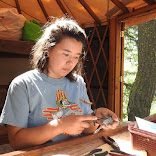Saving the Saguaro, the Hub of the Sonoran Desert
By Aya Pickett
 |
| Saguaros in the Sonoran Desert, John Fowler |
If you’ve visited the Sonoran Desert there’s a high likelihood that you’ve seen a saguaro—it would be difficult not to! The latin name for the saguaro is Carnegia gigantea, and they are truly giants of the desert. The tallest saguaro ever recorded was 78 feet, and they can weigh over 6 tons! These charismatic columnar cacti are a symbol of the desert southwest and are beloved by many who observe them. Saguaros also play a critical role in the lives of many wildlife species.
Saguaros are depended on by a wide variety of fauna—over 100 different species rely on the saguaro. The fruit and flowers of mature saguaros provide an important food source for many species of wildlife. Cavities in saguaros also provide important nesting habitat for many species of birds. Saguaros are a keystone species in the Sonoran Desert, and without them, many species of wildlife would lose critical resources they need to survive and reproduce.
.jpg) |
| A Crested Caracara family nesting in a saguaro, Dan Weisz |
Though mature saguaros can be viewed in great numbers, younger generations are less common. This is because saguaros are picky about the conditions they need to establish from seed. Specifically, they require two good monsoons with a wet winter in between, a pattern that has not occurred in the last 24 years. Therefore, it's been over 2 decades since a new generation of saguaros was established.
In addition to the absence of new generations, mature saguaros are threatened as well. Wildfires pose huge hazards for saguaros, since they are not adapted to fire, and will die off after fire events. In 2020, the Bighorn Fire and the Bush Fire burned over 300,000 acres in total and killed an estimated 420,000 saguaros. These fires were both fueled by buffelgrass, a highly flammable, invasive grass. In combination with the specific requirements saguaro need to establish, this creates major problems for saguaro populations.
 |
| The Mercer Fire of 2019, David Rankin |
In response to these issues, Tucson Audubon is launching a three year project to restore saguaros. The project focuses on three main activities to restore saguaro function.
The first component of the project involves designing and installing 750 saguaro-replicating nest boxes. The nest boxes will be specifically catered to the needs of the Desert Purple Martin, a bird that nests solely in saguaros and other columnar cacti. Many other species of birds could take advantage of the nest boxes as well. American Kestrels, Elf Owls, and Ash-throated Flycatchers are just a few of the species that use saguaro cavities. Saguaro cavities are excavated by woodpeckers in saguaros that are at least 4.5 meters tall. Saguaros grow slowly, and it can take 50-100 years for them to reach this height. By installing saguaro-replicating nestboxes, this process is greatly accelerated.
 |
| Saguaro-replicating nestboxes from the design challenge, 1st Place winner Greg Corman |
The second component of the saguaro project focuses on planting 14,000 nursery-grown saguaros. The nursery-grown saguaros are only a few inches tall, but already have an armor of hard spines and pleats that give them water storage abilities. To give them additional protection, each saguaro will be planted adjacent to existing vegetation that will provide them protection from especially hot or cold temperatures and hide them from hungry herbivores. Saguaros will only be planted while the desert is green, which will further reduce pressure of predation. This effort will largely focus in areas of Tonto National Forest and Coronado National Forest that lost saguaros in recent wildfires.
 |
| Saguaros await planting at the Mason Center, Wyatt Myskow |
The third component of the project targets invasive grasses. One thousand acres of invasive grasses will be removed in areas where there are currently saguaros. Invasive grasses like buffelgrass have long-lasting seed banks and will require repeated treatment. The best time to treat buffelgrass is during the monsoon season when the plants are rapidly growing. Each buffelgrass plant will be sprayed with a blue chemical solution that kills the plant without harming native vegetation.
Each of these points addresses different aspects of saguaro ecology, and we hope that in combination, they will make a big difference for saguaro populations and the wildlife that depend on them. This project is being funded by the Wildlife Conservation Society, Tonto National Forest, and Coronado National Forest, and with the help of local volunteers, over 200 saguaros have already been planted.
If you are interested in planting a saguaro, or would like to know more about the saguaro project, please visit tucsonaudubon.org/saguaro.
Aya Pickett is the Restoration Project Manager at Tucson Audubon.

Comments
Post a Comment
Thanks, we value your opinions! Your comment will be reviewed before being published.